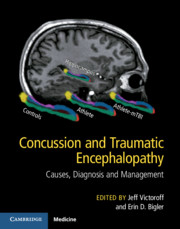Book contents
- Concussion and Traumatic Encephalopathy
- Concussion and Traumatic Encephalopathy
- Copyright page
- Dedication
- Contents
- Guiding Apophthegm
- List of Contributors
- Preface
- Acknowledgments
- Introduction
- Part I What Is a Concussion?
- Part II Outcomes after Concussion
- Part III Diagnosis and Management of Concussion
- Index
- References
Part I - What Is a Concussion?
Published online by Cambridge University Press: 22 February 2019
- Concussion and Traumatic Encephalopathy
- Concussion and Traumatic Encephalopathy
- Copyright page
- Dedication
- Contents
- Guiding Apophthegm
- List of Contributors
- Preface
- Acknowledgments
- Introduction
- Part I What Is a Concussion?
- Part II Outcomes after Concussion
- Part III Diagnosis and Management of Concussion
- Index
- References
- Type
- Chapter
- Information
- Concussion and Traumatic EncephalopathyCauses, Diagnosis and Management, pp. 33 - 284Publisher: Cambridge University PressPrint publication year: 2019

